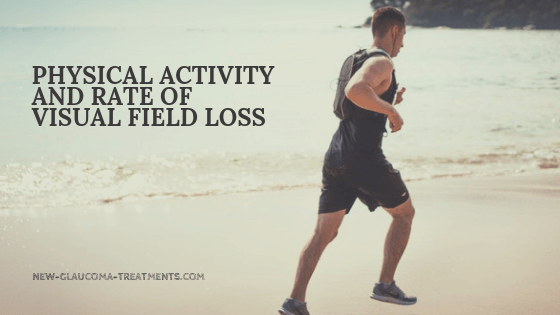
A study to be published in the journal, “Ophthalmology” looked at the association between level of physical activity in patients with glaucoma and rate of visual field loss.[1] This study is what would be called a longitudinal observational study which essentially means that the authors of the study followed a group of people for a long time to see what happened then went back and tried to draw associations between certain activities (such as amount of exercise), and what happened (such as loss of visual field).
Older adults with glaucoma or who were suspected of having glaucoma were given accelerometers (something that now exists in pretty much everyone’s smart phone or watch). They wore these activity monitors for one week. The study authors then analyzed the data based on minutes of activity per week as well as level of intensity.
“In the holistic approach to treating glaucoma, if it’s good for your cardiovascular fitness, it’s probably good for your optic nerve as well.”
The authors also reviewed the visual fields of these patients over time. What they found was that the rate of worsening of visual field loss was correlated with inactivity. In other words, activity (as determined by the one week accelerometer data) seemed to protect from visual field loss.
Now as anyone who has a smartwatch knows, these little accelerometers can detect more than just whether you are moving or not. It’s actually possible to measure number of steps taken, percentage of time spent moving, amount of exertion, etc. The authors of this study looked at this data as well and what they found was that:
- More steps per day was protective
- An additional 5,000 steps per day was associated with a 10% reduction in the rate of visual field loss
- More moderate-to-vigorous activity was protective
- More minutes per day of moderate-to-vigorous activity was protective
Now, it’s worth noting that this study does not tell us whether “physical activity can slow VF loss in glaucoma or if progressive VF loss results in activity restriction.” After all, it’s possible that as one’s visual field is lost fear of accident could increase anxiety about getting around resulting in reduced physical activity.[2]
Assuming the results of this study represent a “modifiable risk factor”, does this mean we all have to join a Cross-Fit gym? No, because:
- Even minutes of “non-sedentary” activity was protective
- It only took about 2.5 hours of extra daily time off the couch to decrease the rate of visual field loss by 10%
In other words, those who spent less time on the couch were less likely to show progressive loss of visual field.
So do we have a definitive answer regarding what types of exercise are best for those with glaucoma? Nope. But I think it’s reasonable to say the following:
- Get off the couch.
- The more time spent moving around, the better.
- If you’ve got glaucoma and could potentially reduce your rate of loss of vision by 10% by doing something as simple and (for most people) easy as taking an extra 5,000 steps each day or just moving around (off a bed, chair, or couch) for 2.5 hours each day, why wouldn’t you?
- If you are healthy enough to do so, moderate cardiovascular exercise is even better.
- Download a pedometer app onto your smartphone or get a pedometer if you don’t have a smartwatch. Here’s one that’s well rated on Amazon.com for under $30:
A pedometer can actually be quite motivating as you see those steps build up you’ll want to add more. And it’ll be good for your heart, help you with weight loss, and…
Well, you probably already know what I’m going to say. In the holistic approach to treating glaucoma, if it’s good for your cardiovascular fitness, it’s probably good for your optic nerve as well.
References:
1 Lee MJ, Wang, J, Friedman DS, et. al. Greater Physical Activity Is Associated with Slower Visual Field Loss in Glaucoma. Presented at: The Association for Research in Vision and Ophthalmology Annual Meeting, May 7–11, 2017, Baltimore, Maryland. (Ophthalmology article in press as of 12/12/2018).
2 Nguyen AM, Arora KS, Swenor BK, et al. Physical activity restriction in age-related eye disease: a cross-sectional study exploring fear of falling as a potential mediator. BMC Geriatr. 2015;15:64.
Related Articles:
- Central Visual Field Loss Associated with More Rapid Vision Loss in Glaucoma
- Association Between Rates of Glaucoma Visual Field Progression and Intraocular Pressure (IOP) Measurements Obtained by Different Tonometers
- Why Don’t Glaucoma Treatments Totally Halt Vision Loss?
- Glaucoma Surgery May Improve Lost Vision
- How Does a High IOP Cause Vision Loss?

David Richardson, MD
Medical Director, San Marino Eye
David Richardson, M.D. is recognized as one of the top cataract and glaucoma surgeons in the US and is among an elite group of glaucoma surgeons in the country performing the highly specialized canaloplasty procedure. Morever, Dr. Richardson is one of only a few surgeons in the greater Los Angeles area that performs MicroPulse P3™ "Cyclophotocoagulation" (MP3) glaucoma laser surgery. Dr. Richardson graduated Magna Cum Laude from the University of Southern California and earned his Medical Degree from Harvard Medical School. He completed his ophthalmology residency at the LAC+USC Medical Center/ Doheny Eye Institute. Dr. Richardson is also an Ambassador of Glaucoma Research Foundation.


